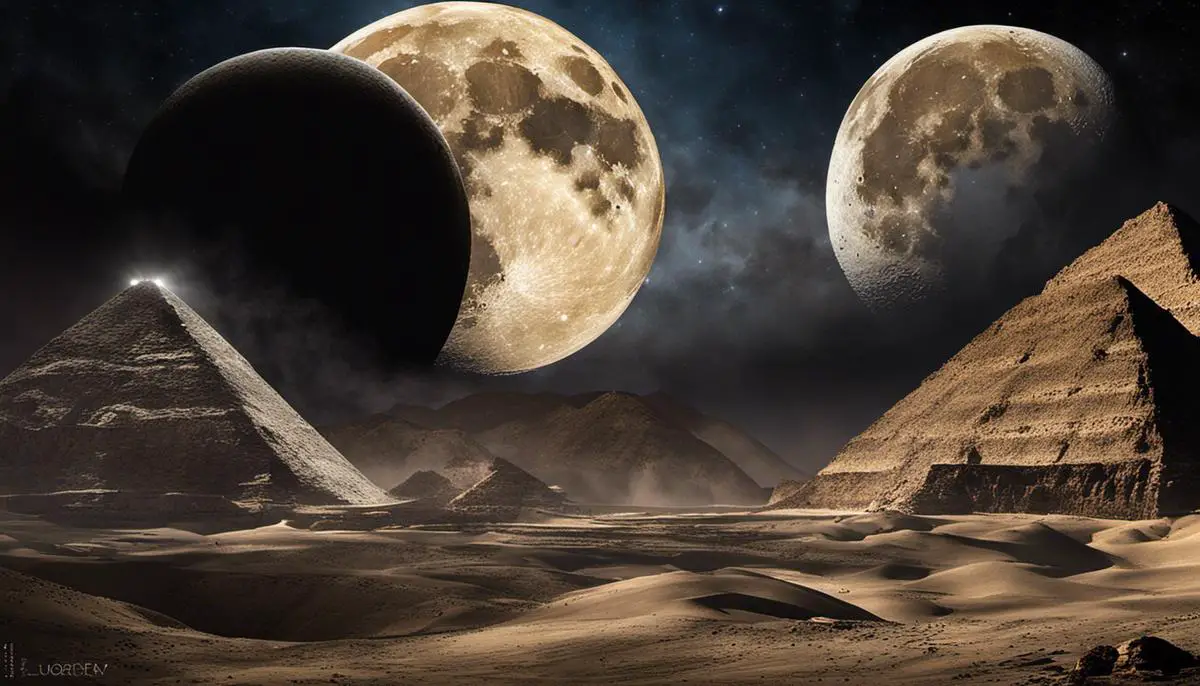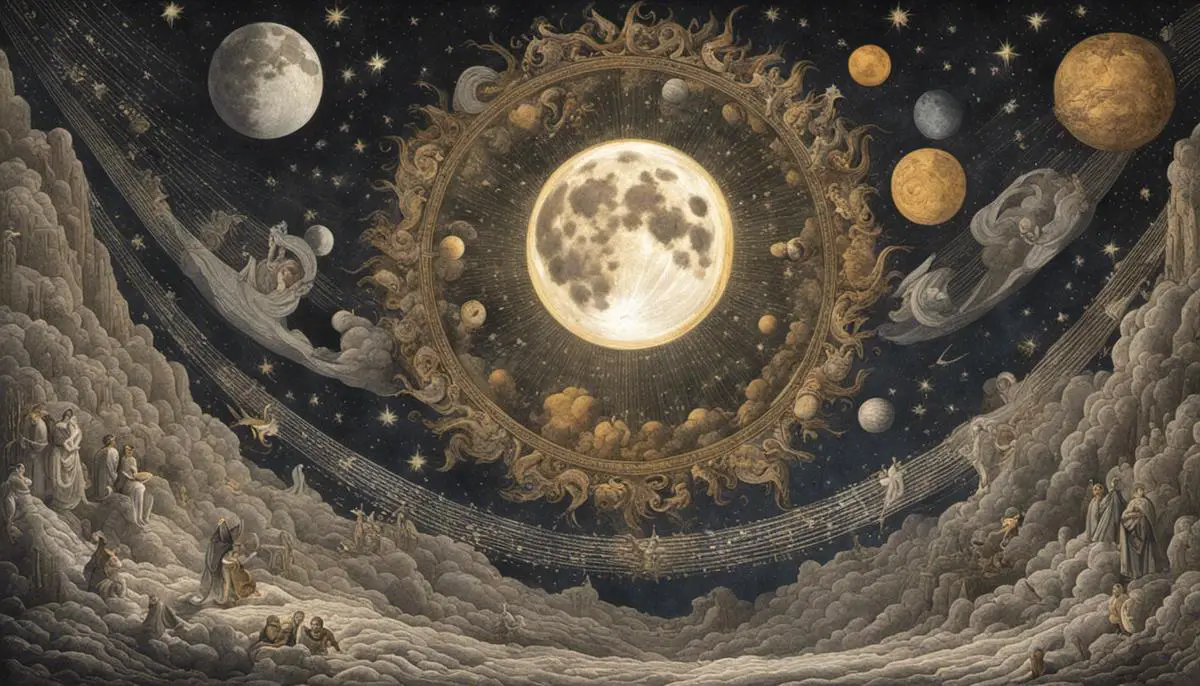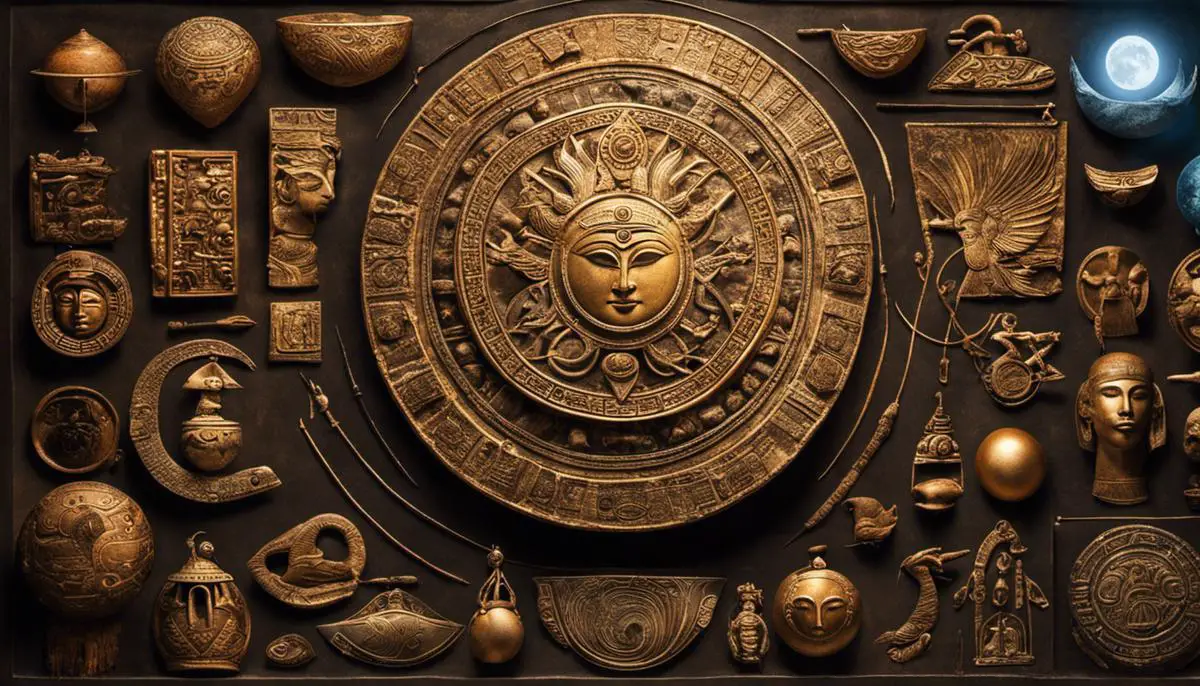The allure of the nightly moon has been a source of wonder and curiosity for mankind since time immemorial. This luminescent celestial body, with its waxing and waning, has stirred the human imagination, sparking tales and beliefs about its creation across diverse cultures and civilizations. Our exploration begins by delving into the rich chronicles of primordial myths and beliefs, shedding light on the earliest illustrations of lunar genesis, engrained in civilizations such as Mesopotamia, Ancient Egypt, and the indigenous tribes of America. We then venture into the realms of monotheistic and polytheistic doctrines, unraveling the tapestry of beliefs held by religions like Christianity, Islam, Judaism, and cultures such as the Greeks, Romans, Norse, and Hindus. Lastly, we juxtapose these historical beliefs against the backdrop of modern scientific understanding about the moon’s origin, offering intriguing insights into evolving human comprehension over time.
Contents
Primordial Myths and Beliefs
“Unveiling Lunar Lore: An Examination of Various Primordial Myths Pertaining to Moon’s Creation.”
As one delves into the realm of cosmogony, the creation stories of various cultures remain a rich tapestry of anthropomorphic deism and astral projections. Notably, the Moon, our closest celestial neighbor, has been the subject of myth and legend across civilizations. Eminent in mystique and beauty, the Moon continues to exert profound cultural, religious, and philosophical influences, encapsulated in a collection of diverse primordial myths.
In the Ancient Near East and Classical Antiquity, the moon was often personified to reflect the dichotomy of living experiences. The Sumerians worshipped Nanna, the moon deity, while in ancient Babylonia, this role was assigned to Sin. In classical Greek mythology, Selene, the Titaness, was the embodiment of the moon; later, her Roman counterpart, Luna, emerged and similarly personified lunar characteristics. These societies attributed the moon’s cyclical ebb and flow to the vicissitudes of these deities’ existence, cementing the moon in a spiritual narrative of life, death, and rebirth.
In Asian folklore, notable is the Chinese myth of Chang’e, the moon goddess. In this narrative, the moon is the goddess’ place of exile after she consuming an elixir of immortality. Consequently, the Moon becomes more than a celestial body; it transforms into a realm beyond mortal reach and a reminder of eternal solitude.
Native American tribes encapsulate the moon’s creation in a compelling mix of natural phenomena and mysticism. The Haida tribe, for instance, narrates that Raven, a transformer god, discovered a giant clamshell with small humans living inside, bathed in light. As he released the humans, he also released the light source, which ascended and transformed into the moon.
African tribal lore, like the Maasai myth, ascribe the creation of the moon to the duality of existence. According to the Maasai, the moon and sun were once married, but a dispute resulted in their separation, causing the moon to grow pale and desperate without the sun’s radiance.
In Polynesian mythology, it is told that the Moon originated from one of the eyes of the primordial being Tahiti, emphasizing the viewing of lunar power as a form of celestial vision, endowed with the gift of prophecy.
In conclusion, the numerous primordial myths surrounding the moon’s creation illustrate the depth and diversity of human responses to the lunar mysteries. Whether envisioned as a deity, a spiritual realm, or an expression of essential dualities, these narratives demonstrate the integral part the moon played and continues to play, in understanding human existence and the cosmos beyond. Each myth unravels a facet of the human quest for comprehending the unknown and finding meaning in the tangible and intangible elements of the universe.
These narratives aren’t simply tales from the past, but critical interpretive lens through which we, as a species, have sought and continue to seek a deeper comprehension of our cosmos – a testament to the enduring allure of our companion in the night sky and the paradoxical intimacy and mystery it echoes in the collective human psyche.

Monotheistic Beliefs
In delving deeper into the study of monotheistic religions and the way they conceptualize the moon’s creation, it becomes evident that these narratives, while diverse, all contain threads of the central belief that the moon, much like other celestial bodies, is a creation of a singular, supreme deity.
Turning first to Judaism, reference to the moon’s creation can be found in the Book of Genesis in the Hebrew Bible or Old Testament. Here, it is identified as the ‘lesser light’ created by God on the fourth day to govern the night, in the company of stars (Genesis 1:16). The moon, together with the sun, serves to mark times and seasons, a practical role conveying its importance in daily and annual rhythms of life.
In Christianity, the narrative of moon’s creation has its roots embedded in Judaism, owing to their shared holy texts, with Genesis serving as the cornerstone. The New Testament, while not delving into cosmogony, does incorporate the moon into its imagery and metaphor – often depicting it darkening or turning to blood as symbols of cosmic disturbance and divine intervention (Acts 2:20; Revelation 6:12).
Islam, derivative of Abrahamic tradition, also maintains the monotheistic account of moon’s creation – Allah, the One God, forming the celestial bodies, including the moon, as signs for creatures wishing to comprehend the workings of the universe. The Qur’an, the holy text of Islam, specifically references the moon’s creation in several verses, notably, “And He completed them as seven heavens within two days and inspired in each heaven its command. And We adorned the nearest heaven with lamps and as protection. That is the measure ordained by the One, the Omniscient.”(41:12)
In examining monotheistic Zoroastrianism, the significant text, ‘Bundahishn’, describes the moon as being created by Ahura Mazda, the Wise Lord, from a beam of radiance that originated from the sun, advancing a slightly different narrative from its Abrahamic counterparts.
The conceptualization of the moon’s creation in Baha’i faith, a relatively late monotheistic religion, emphasizes the symbolic rather than literal interpretations of scripture. Here, the moon’s creation is understood metaphorically; its phases representing our evolving comprehension of divine truth.
In each of these monotheistic traditions, one finds the narrative of the moon’s creation as a testament to the omnipotence and omniscience of a singular deity. The moon, alongside other celestial bodies, is not a deity itself, but a created artifact, a reflection of divine will and design. As with the previous myths that have been explored, these narratives feature the moon as an integral entity in the cosmic order. Its cycle, together with the sun, remains pivotal to human experience intertwined with the celestial, and continues to excite our collective fascination and spiritual reflection.

Polytheistic Beliefs
Polytheism, in its various manifestations across the globe, has always held a diverse array of beliefs about the moon’s creation. Often, these beliefs invoke a myriad of deities, each with their distinct roles and functions.
In Hindu traditions, for instance, the moon is personified as Chandra or Soma, a deity born out of the churning of the cosmic ocean. Revered for his radiant beauty, Chandra forms a principal part of Navagraha, the nine celestial entities in Hindu dharma. The iconography typically depicts Chandra riding in a chariot drawn by antelopes, a symbol of gentle grace and prosperity.
In ancient Egypt, the moon deity Khonsu stood as a symbol of time and the divine natural order with an intriguing creation narrative. According to the myth, Khonsu was one of the children of Amun and Mut; a result of the creative essence of Amun blending with Mut, who personifies the primordial waters. It was believed that every month, Khonsu’s light diminishes, symbolizing his journey through the duat or the underworld. This metaphorical journey was believed to signify a perennial process of death and rebirth.
Up North, among the Norse communities of Scandinavia, Mani, the personification of the moon, was understood as a collector of misused time, often depicted as guiding the chariot of the moon across the night sky. Mani purportedly sprang from the primordial chaos that preceded the ordered cosmos, whose chief architect was the All-Father Odin. The moon, in this perspective, is not merely an astronomical body but is significant in enforcing boundaries and regulating proceedings within the cosmic realm.
The Yoruba people of West Africa, on the other hand, attribute the creation of the moon to the deity Obatala, who descended from the heavens on a chain to establish land out of the chaotic waters below. The moon itself was supposedly crafted out of a silver disk by Orunmila, another Yoruba deity.
In this brief exploration of polytheistic perspectives, we note the remarkable diversity and creativity of ancient belief systems. While these myths may seem fanciful in a modern, scientific context, it’s crucial to understand that these were not illusory tales spun in ignorance. Instead, they were expressive metaphors laden with profound symbolic meanings, articulating timeless human experiences such as temporality, order, and transcendence. Their potency lies not in their factual accuracy but in their capacity to encapsulate and express the deepest layers of human emotions, longing, awe, and wonder. In a way, they serve to remind us of our historical fascination with the moon: that radiant orb continuously waxing and waning in the presence of the vast, impenetrable night.
As such, regardless of the differences in cultural nuances and worldviews, these narratives underpin, invariably and with considerable emphasis, the moon’s cosmic prowess. A significant symbol of the flux of time, the mystical aesthetics of the night, the enigma of light in darkness, and the divine orchestration of the cosmos, the moon’s imagery invariably captures the imagination of humankind across eons and cultures, reinforcing particularly its integral role in our quest for understanding existence and our place in it.

Scientific Comparison
Unveiling the Layers: Ancient Beliefs and Modern Scientific Understanding of the Moon
In the present day, we gaze upon the celestial orb of the moon possessing a concrete understanding of its material nature, constituted by a rich reservoir of scientific knowledge. The moon is a satellite, circling our planet while forming a part of countless processes determining the rhythm of life on earth – the tides, potential influences on animal behavior and potential impact on climate, among others. Our perception of the moon has indeed come a long way from ancient conceptions rooted in mythology and religion, providing a fascinating study of manifold interpretations and understandings.
From the vantage point of modern astronomy, the moon is a rocky body, with its visible surface pockmarked by craters formed by asteroid impacts. Its lack of atmosphere and inability to sustain liquid water have led us to deem it devoid of life – a desolate yet necessary satellite in our night sky. A stark departure from this perspective emerges from ancient Hindu beliefs, which revered the moon as the deity Chandra or Soma, associated with nourishment, fertility and even the elixir of life. Many tales abound of this celestial being falling in and out of favor with other deities, reflecting the ebb and flow of human fortune.
In ancient Egypt, the moon was personified through the deity Khonsu, a god of time, reckoner of lives and protector of travelers, suggesting the moon’s role in guiding and safeguarding the ventures of mankind. This is mirrored in modern astronomy where the moon’s phases serve as a reliable guide to mark time.
Abundant in Norse mythology is the moon-god Mani, another divine embodiment of the moon, steering his chariot across the night sky, pursued incessantly by cosmic wolves as part of the celestial drama. The episodic pursuit and eclipse of the moon portray the inevitable cycles of light and darkness in life, which is mirrored in astronomical phenomena such as lunar eclipses.
An intriguing contrast is seen in the traditions of Yoruba, an ethnic group from West Africa, who revered the deities Obatala and Orunmila. They were not only associated with the moon, but were integral participants in the drama of Creation itself. This belief correlates with modern astronomical concepts affirming the moon’s critical role in the formation of Earth’s stable axis tilt, thereby affecting climate and enabling life as we know it.
The creative diversity of ancient belief systems and the literal interpretations of the moon served not only as explanatory mechanisms but as metaphors expressing deeper truths about the human condition. It was through such narratives that ancient cultures made sense of a bewildering universe, with the moon as a prominent figure in their cosmic theatre.
Modern scientific understanding, while readily dismissing such narratives as mere superstition, must acknowledge the poetic profundity they encapsulate about human existence. From signifying time, representing the alternation of darkness and light, to embodying divine will, the moon represents a shared symbolic language transcending fragmented human cultures.
In this constellation of beliefs, one thing remains unaltered – the enduring fascination and reverence for the moon. While we are far removed from crafting celestial mythologies, the moon continues to inspire and intrigue, beckoning us into its mesmerizing grip, ever driving our quest to decipher the grand puzzle of our existence in the cosmos. Ancient beliefs, when viewed alongside scientific understanding, unveil an intricate tapestry of the human journey – as observers, dreamers, storytellers and explorers – bound by the celestial dance of the Moon.

This exploration into the beliefs about the moon’s creation uncovers a fascinating thread that runs through diverse cultures and religions, reminding us of our ancient fascination with this celestial body. Whether it’s the primordial myths, the monotheistic religious narratives, or the polytheistic symbolism, all these echo a human need to comprehend and contextualize the enigmatic moon within their cultural and spiritual landscape. The scientific revelations, on the other hand, introduce a compelling understanding about the moon’s formation, demonstrating our continual quest to decode the universe. Ultimately, lunar creation beliefs, regardless of being veiled in mythology or etched in science, hold a mirror to humanity’s unending journey of celestial exploration and understanding.
